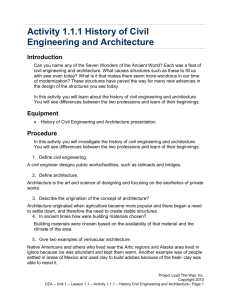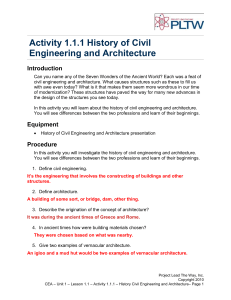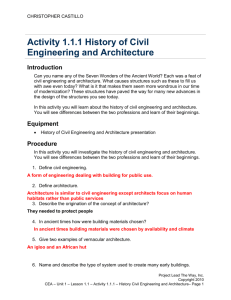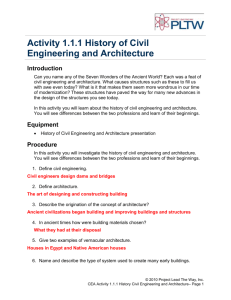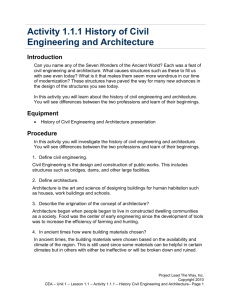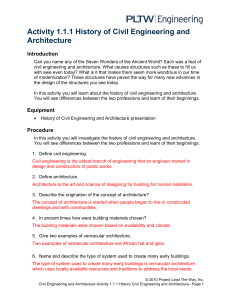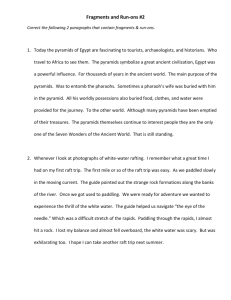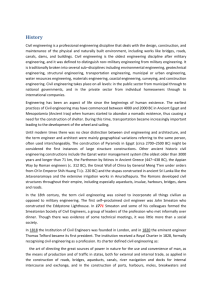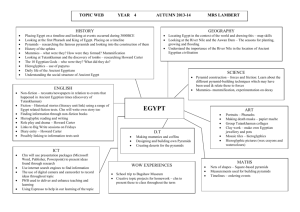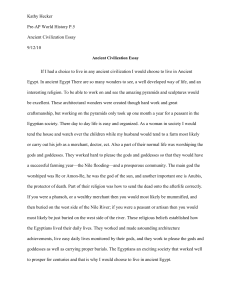File - Mathilde Van L
advertisement
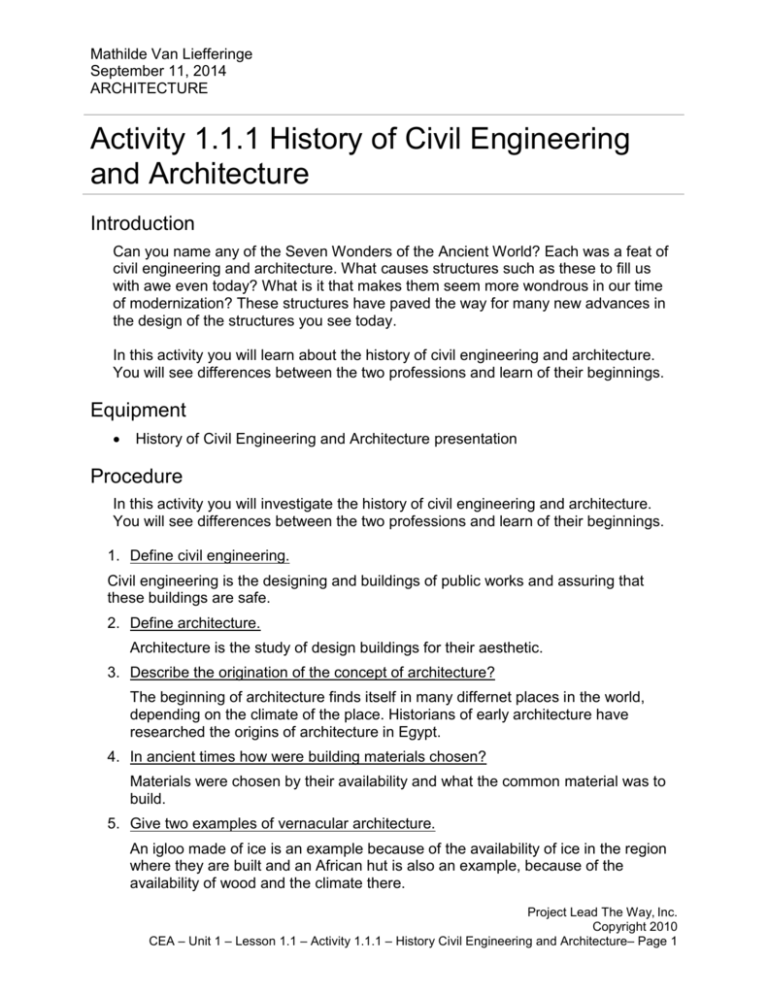
Mathilde Van Liefferinge September 11, 2014 ARCHITECTURE Activity 1.1.1 History of Civil Engineering and Architecture Introduction Can you name any of the Seven Wonders of the Ancient World? Each was a feat of civil engineering and architecture. What causes structures such as these to fill us with awe even today? What is it that makes them seem more wondrous in our time of modernization? These structures have paved the way for many new advances in the design of the structures you see today. In this activity you will learn about the history of civil engineering and architecture. You will see differences between the two professions and learn of their beginnings. Equipment History of Civil Engineering and Architecture presentation Procedure In this activity you will investigate the history of civil engineering and architecture. You will see differences between the two professions and learn of their beginnings. 1. Define civil engineering. Civil engineering is the designing and buildings of public works and assuring that these buildings are safe. 2. Define architecture. Architecture is the study of design buildings for their aesthetic. 3. Describe the origination of the concept of architecture? The beginning of architecture finds itself in many differnet places in the world, depending on the climate of the place. Historians of early architecture have researched the origins of architecture in Egypt. 4. In ancient times how were building materials chosen? Materials were chosen by their availability and what the common material was to build. 5. Give two examples of vernacular architecture. An igloo made of ice is an example because of the availability of ice in the region where they are built and an African hut is also an example, because of the availability of wood and the climate there. Project Lead The Way, Inc. Copyright 2010 CEA – Unit 1 – Lesson 1.1 – Activity 1.1.1 – History Civil Engineering and Architecture– Page 1 6. Name and describe the type of system used to create many early buildings. Pyramids were the most common structures in the ancient world. In Egypt, as well as the Americas, pyramids were built with bearing walls for religious ceremonies and research. 7. What was the purpose of the Egyptian pyramids? Mexican pyramids? In Egypt the pyramids were built for tombs of pharaoahs. These pyramids would be adorned with decorations, commemorating the pharaoas. The Mexican pyramids were used for scientific research, such as astrology, and for sacred religious ceremonies. 8. What kind of construction method was used to build the Parthenon? Made a simple sketch to illustrate. The system used to build the Parthenon is called post-and-lintel. This system comprises of columns being stuck onto horizontal beams. Horizontal Beam Column 9. What problem in architecture led to this form of construction? The Romans wanted to be able to open doors and windows, but they did not know how to do this without bearing walls. This method worked. 10. Explain how an arch is created. Stones are put into place and the voussoir, a small wedge, is put in at the top. The voussoir is the most important part of the arch. The arch would not be able to stand without the voussoir. 11. How is the vault used in civil engineering? Bridges and walkways are examples of where the vault is used in public areas. Perhaps another place where we often see vaults is the subway. 12. Give an example of an arch and dome system. Many cathedrals or other places of worship have domes. Also the U.S. capitol has an arch-dome system. 13. Give an example of a modern material we have that was not available to the ancients. How did this restrict construction in ancient times? Iron is a necessary component to the buildings of today. Iron is lighter so we can build higher buildings with it. Ancient architects did not have this resource. Project Lead The Way, Inc. Copyright 2010 CEA – Unit 1 – Lesson 1.1 – Activity 1.1.1 – History Civil Engineering and Architecture– Page 2 14. What was the purpose of the Roman aqueducts? The aqueducts were needed for water to get into Rome. The water was needed for drinking, agriculture, and bathing. These aqueducts were built by a series of arches. 15. Compare ancient Greek roads to ancient Roman roads. Roman roads were bigger than Greek roads. Also, the Romans used flat stones and layered the roads with broken stone, while the Greeks only had one layer of stone. 16. Describe an ancient Roman bridge. The earliest known Roman bridges were built from wood and used columns and arches to hold it up. After, Romans began to use stone for their bridges while maintaining the arch system. 17. How did building materials and methods change after the Romans? Not much changed until the 18th century, where architects continued to use the same techniques as their predecessors. Iron, structural steel, and reinforced concrete came after the 18th century. These helped build higher buildings and help stability. Conclusion 1. Give an example of a modern pyramid not shown in the presentation. How does its function differ from that of the Egyptian pyramids? What do you think accounts for this difference? The Luxor hotel is an example of a modern day pyramid. 2. Give an example of a modern structure that uses an arch and dome system. The capitol uses an arch and dome system. 3. What is the main purpose of modern roads? How is the cost of modern roadways defrayed? The main purpose of roads now are for transportation. Project Lead The Way, Inc. Copyright 2010 CEA – Unit 1 – Lesson 1.1 – Activity 1.1.1 – History Civil Engineering and Architecture– Page 3
